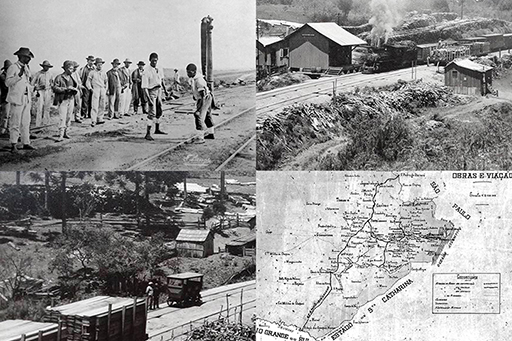
he Estrada de Ferro São Paulo-Rio Grande, or EFSPRG(São Paulo-Rio Grande Railway) linked the Brazilian South and Southwest and transformed life in Paraná in the early years of the Republic. The railway was proposed in 1887 by the engineer João Teixeira Soares. The tracks stretched 1,403 kilometers through provincial interiors and linked Itararé (São Paulo) a Santa Maria (Rio Grande do Sul). The new means of transport created economic possibilities in Campos Gerais. Sawmills and yerba mate processing workshops were built along the tracks, and led to an influx of wage laborers.
The immigrant settlers, dissatisfied with the limited agricultural work available in the colonial centers, found a place in the building of the railway, in lumbering and in the processing of yerba mate.Many came directly from Europe, contracted by the railway company to build bridges and support walls, dig tunnels, and other works along the rails. Others were drawn to the cities, where they established themselves in commerce and specialized services.The wooden stations along the railway promoted the rise of new businesses, concentrated the population, and encouraged urban development.
Percival Farquhar’s Brazil Railway Company (BRC), a holding company, gained control of the EFSPRG in 1909. The Southern Brazil Lumber and Colonization Company (SBLCC), a subsidiary of BRC, was created in order to exploit the woodlands. Fazenda Morungava (now Santa Gil, in the Sengés municipality) was acquired by SBLCC in 1910 and leased to a sawmill concern that supplied the railway with lumber and ties on a grand scale. Peroba timber was cut, and the logs were exported to São Paulo.
The Brazil Railway Company complex entered into debt rehabilitation em 1917.
In 1940, the Getúlio Vargas government took over all the BRC’s assets and merged them with RVPSC (Rede Viação Paraná-Santa Catarina) which in turn was incorporated into RFFSA (Rede Ferroviária Federal S/A) in 1957. In 1997, Ferrovia Sul Atlântico took on the of the southern network of Rede Ferroviária Federal, and began to operate in the Paraná, Santa Catarina e Rio Grande do Sul. Two years later the FSA changed its name to ALL (América Latina Logística S.A).
click on picture
to enlarge